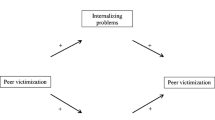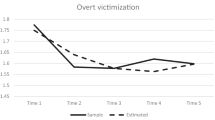Abstract
This study examined self-reports of social victimization and parent reports of adjustment for a sample followed from fourth through seventh grades. Different patterns of social victimization experiences were identified; of the 153 students (79 girls) with complete data, 24% reported chronic social victimization, 23% reported transient experiences of social victimization, and 53% reported being socially victimized at no more than one time point. We examined whether students who experienced persistent and periodic social victimization were at greater risk for internalizing problems than nonvictims. Persistently victimized children demonstrated continuously elevated levels of internalizing problems. Children who were not originally victimized by social aggression but became victimized with time did not demonstrate higher levels of internalizing problems than did nonvictims. Findings were mixed for those who escaped social victimization during this period.


Similar content being viewed by others
References
Achenbach, T. M., & Rescorla, L. A. (2001). Manual for the ASEBA school-age forms and profiles. Burlington: University of Vermont, Research Center for Children, Youth, & Families.
Archer, J., & Coyne, S. M. (2005). An integrated review of indirect, relational, and social aggression. Personality and Social Psychology Review, 9, 212–230.
Baumeister, R. F., & Leary, M. R. (1995). The need to belong: Desire for interpersonal attachments as a fundamental human motivation. Psychological Bulletin, 117, 497–529.
Betan, E. J., Roberts, M. C., & McCluskey-Fawcett, K. (1995). Rates of participation for clinical child and pediatric psychology research: Issues in methodology. Journal of Clinical Child Psychology, 24, 227–235.
Camodeca, M., Goossens, F. A., Terwogt, M. M., & Schuengel, C. (2002). Bullying and victimization among school-age children: Stability and links to proactive and reactive aggression. Social Development, 11, 332–345.
Crick, N. R., & Grotpeter, J. K. (1996). Children's treatment by peers: Victims of relational and overt aggression. Development and Psychopathology, 8, 367–380.
Crick, N. R., & Bigbee, M. A. (1998). Relational and overt forms of peer victimization: A multiinformant approach. Journal of Consulting and Clinical Psychology, 66, 337–347.
Crick, N. R., Casas, J. F., & Ku, H. (1999). Relational and physical forms of peer victimization in preschool. Developmental Psychology, 35, 376–385.
Crick, N. R., Casas, J. F., & Nelson, D. A. (2002). Toward a more comprehensive understanding of peer maltreatment: Studies of relational victimization. Current Directions in Psychological Science, 11, 98–101.
Dempsey, J. P., Fireman, G. D., & Wang, E. (2006). Transitioning out of peer victimization in school children: Gender and behavioral characteristics. Journal of Psychopathology and Behavioral Assessment, 28, 273–282.
Dohrenwend, B. P., & Dohrenwend, B. S. (1981). Socioenvironmental factors, stress, and psychopathology. American Journal of Community Psychology, 9, 128–164.
Galen, B. R., & Underwood, M. K. (1997). A developmental investigation of social aggression among children. Developmental Psychology, 33, 589–600.
Gottman, J., & Mettetal, G. (1986). Speculations about social and affective development: Friendship and acquaintanceship through adolescence. In J. M. Gottman, & J. G. Parker (Eds.), Conversations with friends: Speculations on affective development (pp. 192–237). New York: Cambridge University Press.
Graham, S., Bellmore, A., & Juvonen, J. (2003). Peer victimization in middle school: When self- and peer views diverge. Journal of Applied School Psychology, 19, 117–137.
Hanish, L. D., & Guerra, N. G. (2004). Aggressive victims, passive victims, and bullies: Developmental continuity or developmental change? Merrill-Palmer Quarterly, 50, 17–38.
Haynie, D. L., & Piquero, A. R. (2006). Pubertal development and physical victimization in adolescence. Journal of Research in Crime and Delinquency, 43, 3–35.
Hoover, J. H., Oliver, R., & Hazler, R. J. (1992). Bullying: Perceptions of adolescent victims in the Midwestern USA. School Psychology International, 13, 5–16.
Kochenderfer-Ladd, B., & Skinner, K. (2002). Children’s coping strategies: Moderators of the effects of peer victimization? Developmental Psychology, 38, 267–278.
Kochenderfer-Ladd, B., & Wardrop, J. L. (2001). Chronicity and instability of children's peer victimization experiences as predictors of loneliness and social satisfaction trajectories. Child Development, 72, 134–151.
Kumpulainen, K., Rasanen, E., & Henttonen, I. (1999). Children involved in bullying: Psychological disturbance and the persistence of involvement. Child Abuse & Neglect, 23, 1253–1262.
Ladd, G. W., & Kochenderfer-Ladd, B. (2002). Identifying victims of peer aggression from early to middle childhood: Analysis of cross-informant data for concordance, estimation of relational adjustment, prevalence of victimization, and characteristics of identified victims. Psychological Assessment, 14, 74–96.
Lagerspetz, K. M., Bjorkqvist, K., & Peltonen, T. (1988). Is indirect aggression typical of females? Gender differences in aggressiveness in 11-to 12-year-old children. Aggressive Behavior, 14, 403–414.
La Greca, A. M. (1990). Issues and perspectives on the child assessment process. In A. M. La Greca (Ed.), Through the eyes of the child: Obtaining self-reports from children and adolescents (pp. 3–17). Boston: Allyn & Bacon.
Leadbeater, B. J., Blatt, S. J., & Quinlan, D. M. (1995). Gender-linked vulnerabilities to depressive symptoms, stress, and problem behaviors in adolescents. Journal of Research on Adolescence, 5, 1–29.
Maccoby, E. E. (1998). The two sexes: Growing up apart, coming together. Cambridge: Harvard University Press.
Macdonald, G., & Leary, M. R. (2005). Why does social exclusion hurt? The relationship between social and physical pain. Psychological Bulletin, 131, 202–223.
Miller, J. L., & Vaillancourt, T. (2007). Relation between childhood peer victimization and adult perfectionism: Are victims of indirect aggression more perfectionistic? Aggressive Behavior, 33, 230–241.
Muthén, L. K., & Muthén, B. O. (1998–2007). Mplus User’s Guide. Fifth Edition. Los Angeles: Muthén & Muthén.
Nansel, T. R., Overpeck, M., Pilla, R. S., Ruan, W. J., Simons-Morton, B., & Scheidt, P. (2001). Bullying behaviors among US youth: Prevalence and association with psychosocial adjustment. Journal of the American Medical Association, 285, 2094–2100.
Nishina, A., Juvonen, J., & Witkow, M. (2005). Sticks and stones may break my bones, but names will make me feel sick: The psychosocial, somatic, and scholastic consequences of peer harassment. Journal of Clinical Child and Adolescent Psychology, 34, 37–48.
Nylund, K., Bellmore, A., Nishina, A., & Graham, S. (2007). Subtypes, severity, and structural stability of peer victimization: What does latent class analysis say? Child Development, 78, 1706–1722.
Olweus, D. (1995). Bullying or peer abuse at school: Facts and interventions. Current Directions in Psychological Science, 4, 196–200.
Owens, L., Shute, R., & Slee, P. (2000). ‘Guess what I just heard!’: Indirect aggression among teenage girls in Australia. Aggressive Behavior, 26, 67–83.
Paquette, J. A., & Underwood, M. K. (1999). Gender differences in young adolescents' experiences of peer victimization: Social and physical aggression. Merrill-Palmer Quarterly, 45, 242–266.
Paul, J. J., & Cillessen, A. H. N. (2003). Dynamics of peer victimization in early adolescence: Results from a four-year longitudinal study. Journal of Applied School Psychology, 19, 25–43.
Pellegrini, A. D., & Bartini, M. (2000). A longitudinal study of bullying, victimization, and peer affiliation during the transition from primary school to middle school. American Educational Research Journal, 37, 699–725.
Perry, D. G., Kusel, S. J., & Perry, L. C. (1988). Victims of peer aggression. Developmental Psychology, 24, 807–814.
Perry, D. G., Perry, L. C., & Boldizar, J. P. (1990). Learning of aggression. In M. Lewis, & S. Miller (Eds.), Handbook of developmental psychopathology (pp. 135–146). New York: Plenum Press.
Prinstein, M. J., Boergers, J., & Vernberg, E. M. (2001). Overt and relational aggression in adolescents: Social–psychological adjustment of aggressors and victims. Journal of Clinical Child Psychology, 30, 479–491.
Raudenbush, S. W., Bryk, A. S., Cheong, Y. F., & Congdon, R. T. (2004). HLM 6: Hierarchical linear and nonlinear modeling. Lincolnwood: Scientific, Software International.
Reinke, W. M., Herman, K. C., Petras, H., & Ialongo, N. S. (2008). Empirically derived subtypes of child academic and behavior problems: Co-occurrence and distal outcomes. Journal of Abnormal Child Psychology, 36, 759–770.
Rigby, K., & Slee, P. T. (1991). Bullying among Australian school children: Reported behavior and attitudes to victims. Journal of Social Psychology, 131, 615–627.
Roth, D. A., Coles, M. E., & Heimberg, R. G. (2002). The relationship between memories for childhood teasing and anxiety and depression in adulthood. Journal of Anxiety Disorders, 16, 149–164.
Schafer, M., Korn, S., Brodbeck, F. C., Wolke, D., & Schulz, H. (2005). Bullying roles in changing contexts: The stability of victim and bully roles from primary to secondary school. International Journal of Behavioral Development, 29, 323–335.
Scholte, R. H. J., Engels, R. C. M. E., Overbeek, G., de Kemp, R. A. T., & Haselager, G. J. T. (2007). Stability in bullying and victimization and its association with social adjustment in childhood and adolescence. Journal of Abnormal Child Psychology, 35, 217–228.
Schwartz, D., Gorman, A. H., Nakamoto, J., & Toblin, R. L. (2005). Victimization in the peer group and children’s academic functioning. Journal of Educational Psychology, 97, 425–435.
Sifers, S. K., Puddy, R. W., Warren, J. S., & Roberts, M. C. (2002). Reporting of demographics, methodology, and ethical procedures in journals in pediatric and child psychology. Journal of Pediatric Psychology, 27, 19–25.
Smith, P. K., Talamelli, L., Cowie, H., Naylor, P., & Chauhan, P. (2004). Profiles of nonvictims, escaped victims, continuing victims and new victims of school bullying. British Journal of Educational Psychology, 74, 565–581.
Storch, E. A., & Masia-Warner, C. (2004). The relationship of peer victimization to social anxiety and loneliness in adolescent females. Journal of Adolescence, 27, 351–362.
Storch, E. A., Brassard, M. R., & Masia-Warner, C. L. (2003). The relationship of peer victimization to social anxiety and loneliness in adolescence. Child Study Journal, 33, 1–18.
Sullivan, H. S. (1953). The interpersonal theory of psychiatry. New York: Norton.
Sullivan, T. N., Farrell, A. D., & Kliewer, W. (2006). Peer victimization in early adolescence: Association between physical and relational victimization and drug use, aggression, and delinquent behaviors among urban middle school students. Development and Psychopathology, 18, 119–137.
Sweeting, H., Young, R., West, P., & Der, G. (2006). Peer victimization and depression in early-mid adolescence: A longitudinal study. British Journal of Educational Psychology, 76, 577–594.
Twenge, J. M., Baumeister, R. F., Tice, D. M., & Stucke, T. S. (2001). If you can’t join them, beat them: Effects of social exclusion on aggressive behavior. Journal of Personality and Social Psychology, 81, 1058–1069.
Twenge, J. M., Catanese, K. R., & Baumeister, R. F. (2002). Social exclusion causes self-defeating behavior. Journal of Personality and Social Psychology, 83, 606–615.
Underwood, M. K. (2003). Social aggression among girls. New York: Guilford.
Vaillancourt, T., Miller, J. L., Fagbemi, J., Cote, S., & Tremblay, R. E. (2007). Trajectories and predictors of indirect aggression: Results from a nationally representative longitudinal study of Canadian children aged 2–10. Aggressive Behavior, 33, 314–326.
Author information
Authors and Affiliations
Corresponding author
Additional information
This research was supported by NIMH grants R01 MH63076 and K02 MH073616. We are deeply grateful for the participation of children and families in this study and for the cooperation of a local school system that wishes to go unnamed. We thank Mikal Galperin for her help with recruiting and retaining the sample.
Rights and permissions
About this article
Cite this article
Rosen, L.H., Underwood, M.K., Beron, K.J. et al. Persistent versus Periodic Experiences of Social Victimization: Predictors of Adjustment. J Abnorm Child Psychol 37, 693–704 (2009). https://doi.org/10.1007/s10802-009-9311-7
Published:
Issue Date:
DOI: https://doi.org/10.1007/s10802-009-9311-7




